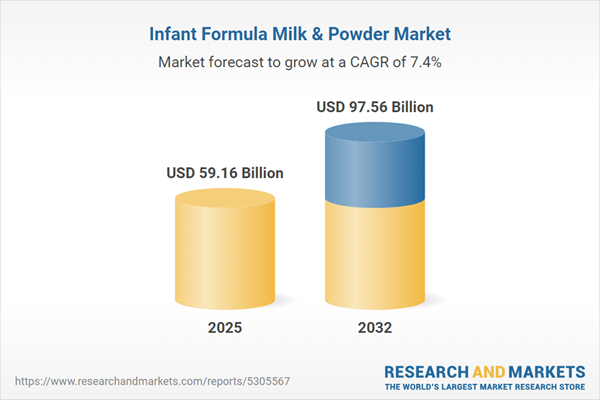Speak directly to the analyst to clarify any post sales queries you may have.
The infant formula milk and powder market is transforming rapidly, driven by new consumer expectations, shifting policy landscapes, and evolving supply chain models. Companies must adapt with agility and strategic foresight to secure growth and mitigate emerging risks in a fast-changing global context.
Market Snapshot: Strong Growth and Evolving Industry Dynamics
The global infant formula milk and powder market expanded from USD 55.31 billion in 2024 to USD 59.16 billion in 2025 and is projected to reach USD 97.56 billion by 2032, at a 7.35% CAGR. This upward trajectory reflects multifaceted demand, including premium nutrition solutions tailored for varying developmental needs. Senior executives will need to monitor the interplay between accelerating health and wellness trends, technology adoption, and regulatory environments as sector boundaries evolve in the coming years.
Scope & Segmentation Across the Infant Formula Milk & Powder Market
This report delivers comprehensive intelligence across critical market segments and geographic regions. By addressing distinct consumer groups, production techniques, and pathways to market, it offers unparalleled depth for informed strategic planning.
- Product Types: First infant formula, follow-on formula, and growing-up milk for toddlers
- Formulation Types: Concentrated liquid, dry powder, and ready-to-feed varieties
- Ingredient Types: Cow's milk, goat's milk, plant-based, and soy protein alternatives
- Sources: Conventional and organic
- Distribution Channels: Offline (convenience stores, pharmacies and drug stores, specialty baby outlets, supermarket and hypermarket chains) and online (brand websites, eCommerce platforms)
- Regional Coverage: Americas (United States, Canada, Mexico, Brazil, Argentina, Chile, Colombia, Peru); Europe, Middle East & Africa (United Kingdom, Germany, France, Russia, Italy, Spain, Netherlands, Sweden, Poland, Switzerland, UAE, Saudi Arabia, Qatar, Turkey, Israel, South Africa, Nigeria, Egypt, Kenya); Asia-Pacific (China, India, Japan, Australia, South Korea, Indonesia, Thailand, Malaysia, Singapore, Taiwan)
- Company Analysis: Major players such as Abbott Laboratories, Danone S.A., Nestlé S.A., FrieslandCampina, Bellamy's Australia Pty Ltd, and others highlighted for product innovation and operational advances.
Key Takeaways for Senior Decision-Makers
- Premiumization is accelerating, with growing demand for organic, goat's milk, and plant-based formulas as consumers focus on tailored nutrition and ingredient transparency.
- Digital transformation is reshaping engagement and distribution, with omnichannel integration and mobile platforms unlocking personalized guidance and loyalty pathways.
- Supply chain resiliency and traceability are increasingly mission-critical, supported by advanced analytics, blockchain, and eco-focused packaging strategies.
- Strategic partnerships, mergers, and acquisitions are enabling companies to access new ingredients, enter niche market segments, and strengthen competitive positioning.
- Regional variations demand nuanced approaches, from evolving regulatory frameworks in North America and Europe to swift digital adoption and local manufacturing initiatives in Asia-Pacific.
- Operational excellence bolstered by certifications, predictive maintenance tools, and quality management systems continues to drive industry benchmarks and trust.
Tariff Impact: Responding to United States Policy Changes
Recent tariff policy adjustments in the United States have directly influenced import flows and prompted manufacturers to re-engineer sourcing strategies. Some companies are realigning their supply bases and local production footprints, while others are engaging in new contract manufacturing partnerships to mitigate cost volatility and support supply reliability. Enhanced compliance frameworks and risk mitigation mechanisms are becoming standard, reinforcing sectoral resilience and supporting product innovation for consumers.
Methodology & Data Sources
This report is underpinned by a rigorous methodology blending quantitative and qualitative analysis. It incorporates executive interviews with industry stakeholders, pediatric nutrition experts, and frontline caregivers. Data triangulation, competitive benchmarking, scenario modeling, and a comprehensive review of public regulatory filings and corporate disclosures ensure analytical rigor and reliable insights.
Why This Report Matters
- Enables senior leaders to assess evolving market forces, identify new high-growth opportunities, and benchmark against innovative competitors.
- Delivers actionable recommendations for optimizing product portfolios, marketing strategies, and regional supply chain configurations.
- Empowers informed decision-making to navigate policy changes, shifting consumer preferences, and sustainability imperatives.
Conclusion
The infant formula milk and powder market is undergoing significant transformation, shaped by consumer demands, technology integration, and regulatory change. Forward-focused strategies and continuous innovation are vital for sustained leadership as the sector advances.
Additional Product Information:
- Purchase of this report includes 1 year online access with quarterly updates.
- This report can be updated on request. Please contact our Customer Experience team using the Ask a Question widget on our website.
Table of Contents
3. Executive Summary
4. Market Overview
7. Cumulative Impact of Artificial Intelligence 2025
Companies Mentioned
The companies profiled in this Infant Formula Milk & Powder market report include:- Abbott Laboratories
- Arla Foods amba
- Ausnutria B.V.
- Bellamy’s Australia Pty Ltd
- Biostime
- Bobbie Baby, Inc.
- Bubs Australia Limited
- Dana Dairy Group
- Danone S.A.
- Ezaki Glico Co., Ltd.
- FrieslandCampina
- Heilongjiang Feihe Dairy Co., Ltd.
- Hero Group
- Holle baby food AG
- Isigny Sainte-Mère
- Kendal Nutricare Ltd.
- Lactalis Nutrition Santé
- Maeil Co., Ltd.
- Mead Johnson & Company, LLC
- Meiji Holdings Co., Ltd.
- Morinaga Milk Industry Co., Ltd.
- Namyang Dairy Products Co., Ltd.
- Nestlé S.A.
- Synutra International, Inc.
- The a2 Milk Company Limited
- The Hain Celestial Group, Inc.
Table Information
| Report Attribute | Details |
|---|---|
| No. of Pages | 180 |
| Published | November 2025 |
| Forecast Period | 2025 - 2032 |
| Estimated Market Value ( USD | $ 59.16 Billion |
| Forecasted Market Value ( USD | $ 97.56 Billion |
| Compound Annual Growth Rate | 7.3% |
| Regions Covered | Global |
| No. of Companies Mentioned | 27 |









